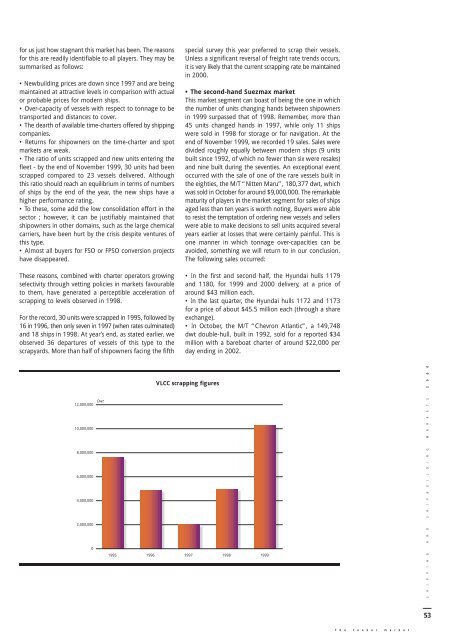Create successful ePaper yourself
Turn your PDF publications into a flip-book with our unique Google optimized e-Paper software.
for us just how stagnant this market has been. The reasons<br />
for this are readily identifiable <strong>to</strong> all players. They may be<br />
summarised as follows:<br />
• Newbuilding prices are down since 1997 and are being<br />
maintained at attractive levels in comparison with actual<br />
or probable prices for modern ships.<br />
• Over-capacity of vessels with respect <strong>to</strong> <strong>to</strong>nnage <strong>to</strong> be<br />
transported and distances <strong>to</strong> cover.<br />
• The dearth of available time-charters offered by shipping<br />
companies.<br />
• Returns for shipowners on the time-charter and spot<br />
markets are weak.<br />
• The ratio of units scrapped and new units entering the<br />
fleet - by the end of November 1999, 30 units had been<br />
scrapped compared <strong>to</strong> 23 vessels delivered. Although<br />
this ratio should reach an equilibrium in terms of numbers<br />
of ships by the end of the year, the new ships have a<br />
higher performance rating.<br />
• To these, some add the low consolidation effort in the<br />
sec<strong>to</strong>r ; however, it can be justifiably maintained that<br />
shipowners in other domains, such as the large chemical<br />
carriers, have been hurt by the crisis despite ventures of<br />
this type.<br />
• Almost all buyers for FSO or FPSO conversion projects<br />
have disappeared.<br />
These reasons, combined with charter opera<strong>to</strong>rs growing<br />
selectivity through vetting policies in markets favourable<br />
<strong>to</strong> them, have generated a perceptible acceleration of<br />
scrapping <strong>to</strong> levels observed in 1998.<br />
For the record, 30 units were scrapped in 1995, followed by<br />
16 in 1996, then only seven in 1997 (when rates culminated)<br />
and 18 ships in 1998. At year’s end, as stated earlier, we<br />
observed 36 departures of vessels of this type <strong>to</strong> the<br />
scrapyards. More than half of shipowners facing the fifth<br />
Dwt<br />
12,000,000<br />
10,000,000<br />
8,000,000<br />
6,000,000<br />
4,000,000<br />
2,000,000<br />
0<br />
special survey this year preferred <strong>to</strong> scrap their vessels.<br />
Unless a significant reversal of freight rate trends occurs,<br />
it is very likely that the current scrapping rate be maintained<br />
in 2000.<br />
• The second-hand Suezmax market<br />
This market segment can boast of being the one in which<br />
the number of units changing hands between shipowners<br />
in 1999 surpassed that of 1998. Remember, more than<br />
45 units changed hands in 1997, while only 11 ships<br />
were sold in 1998 for s<strong>to</strong>rage or for navigation. At the<br />
end of November 1999, we recorded 19 sales. Sales were<br />
divided roughly equally between modern ships (9 units<br />
built since 1992, of which no fewer than six were resales)<br />
and nine built during the seventies. An exceptional event<br />
occurred with the sale of one of the rare vessels built in<br />
the eighties, the M/T “Nitten Maru”, 180,377 dwt, which<br />
was sold in Oc<strong>to</strong>ber for around $9,000,000. The remarkable<br />
maturity of players in the market segment for sales of ships<br />
aged less than ten years is worth noting. Buyers were able<br />
<strong>to</strong> resist the temptation of ordering new vessels and sellers<br />
were able <strong>to</strong> make decisions <strong>to</strong> sell units acquired several<br />
years earlier at losses that were certainly painful. This is<br />
one manner in which <strong>to</strong>nnage over-capacities can be<br />
avoided, something we will return <strong>to</strong> in our conclusion.<br />
The following sales occurred:<br />
• In the first and second half, the Hyundai hulls 1179<br />
and 1180, for 1999 and 2000 delivery, at a price of<br />
around $43 million each.<br />
• In the last quarter, the Hyundai hulls 1172 and 1173<br />
for a price of about $45.5 million each (through a share<br />
exchange).<br />
• In Oc<strong>to</strong>ber, the M/T “Chevron Atlantic”, a 149,748<br />
dwt double-hull, built in 1992, sold for a reported $34<br />
million with a bareboat charter of around $22,000 per<br />
day ending in 2002.<br />
VLCC scrapping figures<br />
1995 1996 1997 1998 1999<br />
T h e t a n k e r m a r k e t<br />
S H I P P I N G A N D S H I P B U I L D I N G M A R K E T S 2 0 0 0<br />
53


